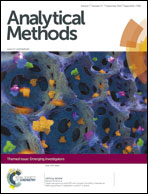DNA–bare gold affinity interactions: mechanism and applications in biosensing
Abstract
The adsorption of DNA onto gold due to affinity interactions is highly desirable for developing low-cost, convenient and sensitive biosensors. To date, DNA–gold adsorption phenomenon has been demonstrated as one of the most promising physical mechanisms for achieving precise control over unmodified gold nanoparticles (AuNPs) aggregation, and DNA monolayer formation on gold surfaces. The adsorption phenomenon is exquisitely controlled by many factors including intermolecular forces, along with DNA composition and sequence. The understanding and manipulation of these factors have allowed broad biosensing applications and notably, sequence-dependent DNA–gold adsorption which may be highly relevant for DNA methylation detection in cancer. Herein, we review the underlying principles governing DNA–gold adsorption as well as recent biosensing strategies based on differential ssDNA/dsDNA–AuNPs adsorption and sequence-dependent DNA–gold adsorption. Finally, we have also contributed insights regarding the future trend of DNA–gold adsorption-based biosensors.

- This article is part of the themed collection: Emerging Investigators

 Please wait while we load your content...
Please wait while we load your content...